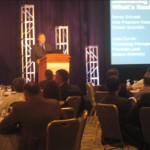Invention Machine’s CTO on Open Innovation
Point: When reviewing the ideas submitted to your open innovation portal, identify ideas that have momentum and ideas that are outliers.
Story: Open innovation efforts yield many ideas, often too many to use. So, what’s the best way to manage and  make productive use of the ideas you receive? To answer this, I interviewed Jim Todhunter, CTO of Invention Machine, as part of the Open Innovation Summit held in Orlando December 3-4, 2009. I asked Jim about how Invention Machine Goldfire software can be used in open innovation efforts. He described three key tasks to do after you have received a set of submissions from an open innovation effort.
make productive use of the ideas you receive? To answer this, I interviewed Jim Todhunter, CTO of Invention Machine, as part of the Open Innovation Summit held in Orlando December 3-4, 2009. I asked Jim about how Invention Machine Goldfire software can be used in open innovation efforts. He described three key tasks to do after you have received a set of submissions from an open innovation effort.
The first step is to organize the ideas into buckets. Todhunter described how Goldfire speeds this process and reveals relationships among ideas as well. Goldfire uses semantic technology, which means that it’s not limited to finding exact keyword matches when searching or analyzing submissions. Rather, semantic engines understand the meaning of the words, so they can cluster related ideas regardless of the specific terms that users submitted. That’s a useful feature for open innovation, because people often use different terms or nonstandard words in their submissions. Semantic technologies find text that has similar meaning, even if it does not use identical words.
Todhunter illustrated the second step with a hypothetical example. Let’s say you’re a medical device company looking for innovations related to sphygmomanometers (the familiar arm-cuff device for measuring blood pressure). Goldfire will automatically divide your open innovation ideas into different tiers of concepts. Top-level tiers are general concepts and concepts around functionality. Finer-grained buckets under these meta-categories are categories like advantages and disadvantages that your customers see about your product or competing products. For example, within the “advantages” cluster you might notice that a customer submitted an idea referencing an advantage of a competing product by saying “this other sphygmomanometer doesn’t pinch when people pump it up.” Regardless of the specific terms that a person uses, Goldfire can identify a concept like “pain-free use” and create a cluster of that concept. If several other people use terms such as “pinch” “hurt” “discomfort” or “squeeze”, then you know that’s a key issue to focus on. Identifying ideas that have momentum helps the company serve existing customers better.
But it’s not just the momentum ideas that have value. In the third step, you identify a different type of potentially valuable suggestion. Specifically, Goldfire looks for what Todhunter called “singularities” — outlier ideas that had very little discussion. Outlier ideas may be worth nothing or they may be the future of the company. On one hand, the dearth of discussion might mean that the idea wasn’t very useful. On the other hand, that singularity may be next new application that is just starting to emerge. “Singularities represent interesting, unique points of value that may relate to unserved audiences, new applications, new applications of technology, or new pockets of interest that you as a company haven’t served — these can be your underserved communities that create the opportunity for new disruptive market elements,” Todhunter said.
Action:
1. Gather as many open innovation idea submissions as possible
2. Quickly bucket the ideas (and parts of ideas) to look for patterns
3. Look for the most-mentioned ideas to find high-priority innovations
4. Also look for outliers to find potential high-value innovations.
For more information:
Jim Todhunter’s blog: Innovating to Win
2P3M65K4HRDW
Comments Off on Invention Machine’s CTO on Open InnovationInnovation, New Product Development, Opportunity, Software tool











